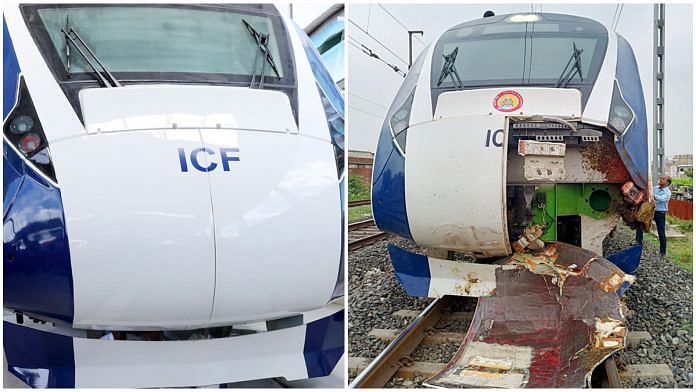New Delhi: Ever since its maiden run on 30 September, the Gandhinagar-Mumbai Vande Bharat Express has been in the news for its back-to-back run-ins with bovines. The semi-high speed train suffered minor damage on two separate occasions upon colliding with stray cattle.
No damage was reported, except for the nose cone-shaped cover of the driver’s coach, said senior officials of the Ministry of Railways. The train resumed operations shortly after the collision on both occasions, they said, adding that the damaged nose cone cover was subsequently replaced during routine maintenance at Mumbai Central depot.
Train accidents involving cattle are not uncommon, said a senior railways official who did not wish to be named, adding that though there has been a surge in the number of ‘cattle run over’ (CRO) by trains lately, not much can be done to prevent such incidents owing to open access to railway tracks across the country.
The official also said that railway tracks running through residential stretches have been barricaded either with reinforced concrete walls or barbed wire in many areas but a large portion — including along the route of the three Vande Bharat trains — is unfenced and hence, susceptible.
“It is more of a socio-economic problem here [in India] than a technical one,” said the official.
Explaining why it is not feasible for the railways to barricade tracks from one end to the other, the official told ThePrint: “In villages, people have their houses on one side of the track and their fields on the other side. If we barricade the track, it will obstruct their access to the other side of the track. It could not only block their movement in their own village but also block access to adjoining villages.”
It’s not that barricading is not done at all to ensure track safety. For instance, the entire stretch of Mumbai-Ahmedabad bullet train and Regional Rapid Transit System — connecting National Capital Region (NCR) and Delhi — will be barricaded.
Fencing is already done along metro rail tracks, said a second railways official on condition of anonymity, adding that barricading the entire stretch “increases the project cost significantly”.
“For instance, an overground metro track costs about Rs 150 crore per km as against Rs 3-4 crore per km for a regular track on railway land. If you barricade the entire stretch of a regular track, the cost will also go up,” the official added.
Also Read: Stations, gymkhanas, bungalows—New book takes Indian Railways past beyond KBC, UPSC questions
Replaceable nose cone-shaped covers
In the case of Vande Bharat, instances of ‘cattle run over’ (CRO) were factored in during the designing phase. This is why the replaceable nose cone-shaped cover of its driver’s coach is made of fibre-reinforced plastic and designed to absorb the impact of a collision with stray cattle.
“While developing the train, we make not one but several nose cones,” said the second railways official, who was involved in the designing phase of the semi high-speed train manufactured at Chennai’s Integral Coach factory.
A nose cone-shaped cover is a low cost item and costs anywhere between Rs 10,000 to Rs 15,000 per piece. At least ten spare covers were made for the third Vande Bharat Express flagged off last month by PM Narendra Modi.
“How else do you think the damaged nose cones were replaced so quickly if we did not have spares,” said the second official when asked about whether railways had anticipated ‘CRO’ incidents along the Gandhinagar-Mumbai route of the Vande Bharat Express.
Even for the first two Vande Bharat trains, the railways had spare nose cone-shaped covers in stock. “Nose cones of both previous Vande Bharat trains have also been replaced once or twice after they were damaged upon colliding with cattle,” said the first railways official.
Surge in ‘CROs’
Number of ‘cattle run over’ (CRO) has risen steadily across the country over the last decade, from about 2,000-3,000 in 2014-15 to over 14,000 in 2017-18 and 27,046 in 2019-20. This number declined to 19,949 in the pandemic year 2020-21 but witnessed a surge again — 26,142 in 2021-22.
This data, recorded by railway zones and compiled at the central level, shows that Northern railway and North Central Railways account for nearly 50 per cent of all CROs. These incidents can cause delay in train operations and at times, even lead to derailment.
“It (CRO) keeps happening all the time. Because it does not get reported every time it happens, people don’t get to know,” said the first railways official.
According to data made available to ThePrint by the Ministry of Railways, over 15 bovines were run over by trains on average each day between January and September 2022, affecting the operations of 4,233 trains.
The number of CROs has always been higher than the number of recorded instances of ‘human run over’ (HRO) by trains which was 11,182 in 2019-20 and 7,185 in 2020-21.
(Edited by Amrtansh Arora)
Also Read: A 20-year battle for Rs 20 — lawyer who sued Railways & won says it wasn’t just about money



